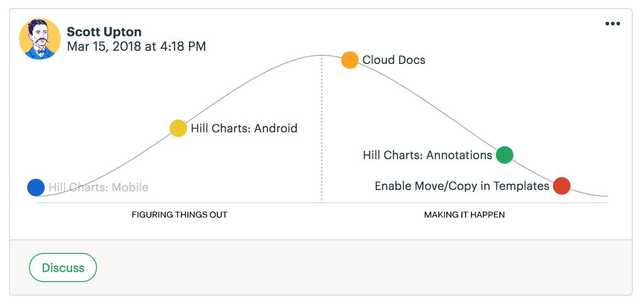My New Crush Is the Hill Chart
Hill Chart is a Basecamp invention that let’s you have a 10,000-feet view of your project. Here’s what a Hill Chart looks like:
The hill is divided into two parts. You have the uphill which is all about figuring things out. And then you have the downhill for implementation.
Your main project’s smaller sub-projects are placed on that hill depending on where you think they currently are in terms of progress. If you haven’t figured out how you’re going to finish one of the sub-projects or if there are many known unknowns, you place that sub-project on the uphill. Once you reach a point where those known unknowns are solved, you can place the sub-project on the downhill.
As a result, if you look at a Hill Chart you can see what’s actually finished, what’s going to get finished and what needs to be figured out. That’s so much more helpful when it comes to answering the question of how ready your project is compared to some double-digit percentage number or the number of items in your product backlog.
I’m not really a Basecamp user. This post is not about a software feature. I just want to tell you why I love the idea of the Hill Chart.
There’s the part that’s easy to like…
I have a really hard time with keeping many things in my head at the same time. When you have a new project, it’s pretty easy to have a comprehensive understanding of what you’re doing now and what needs to be done next because the project isn’t that big yet in terms of project details. But once time progresses your project will become more complex as new issues emerge and as you start breaking big tasks into smaller tasks.
At this point I usually get overwhelmed by all of these new details. My anxiety levels shoot up as I feel less in control.
For me, the best way to combat these counter-productive emotions is to restore that initial understanding of the project the best I can. I try to look at the big picture. For a second, I try to remove the details from my mind. I try to see how far I’ve come, where I’m right now and what’s still ahead.
This is why I like User Story Maps more than plain old Kanban boards. When I look at a Kanban board, I don’t see where I’m at. All I see is details. With a User Story Map I get the big picture. I can see the project backbone. I get to see why we’re building the thing we’re building.
And this is why I love the Hill Chart. I look at Basecamp’s examples of Hill Charts and I have no idea what are the details of those samples. I have no idea what’s the backstory. I have no idea who the team is. But I feel like I have a deeply satisfying understanding of the overall state of the project.
…and there’s the part that requires some work from me
If I want to embrace the Hill Chart, I need to embrace one thing that I’m not comfortable with. This one thing is that this is a chart that’s not metric driven nor will it ever be.
You can’t first measure your work hours or your finished tasks and then place your dot at some exact point on the Hill Chart. You honestly just place the dot where you feel like it needs to be placed at.
Hill Chart is a chart, driven by qualitative data instead of a chart driven by quantitative data.
Qualitative data is messy and ambiguous. Quantitative data, on the other hand, is more or less just factual data about something. Messy and ambiguous means that you have to have more interactions with people to create a shared understanding of the data. Messy and ambiguous means that you will never stop questioning whether your data is correct or not.
But there is so much value in that qualitative data. There is value in those interactions and discussions with real people. There is value in not going on an endless search for an absolute truth if you can give a close enough data point right now, today.
Learn more
If you want to learn more about the Hill Chart, here is Basecamp’s blog post about it https://m.signalvnoise.com/new-in-basecamp-see-where-projects-really-stand-with-the-hill-chart-ca5a6c47e987. Here is their YouTube video about the chart https://www.youtube.com/watch?v=UlLkS0lxRV0.
